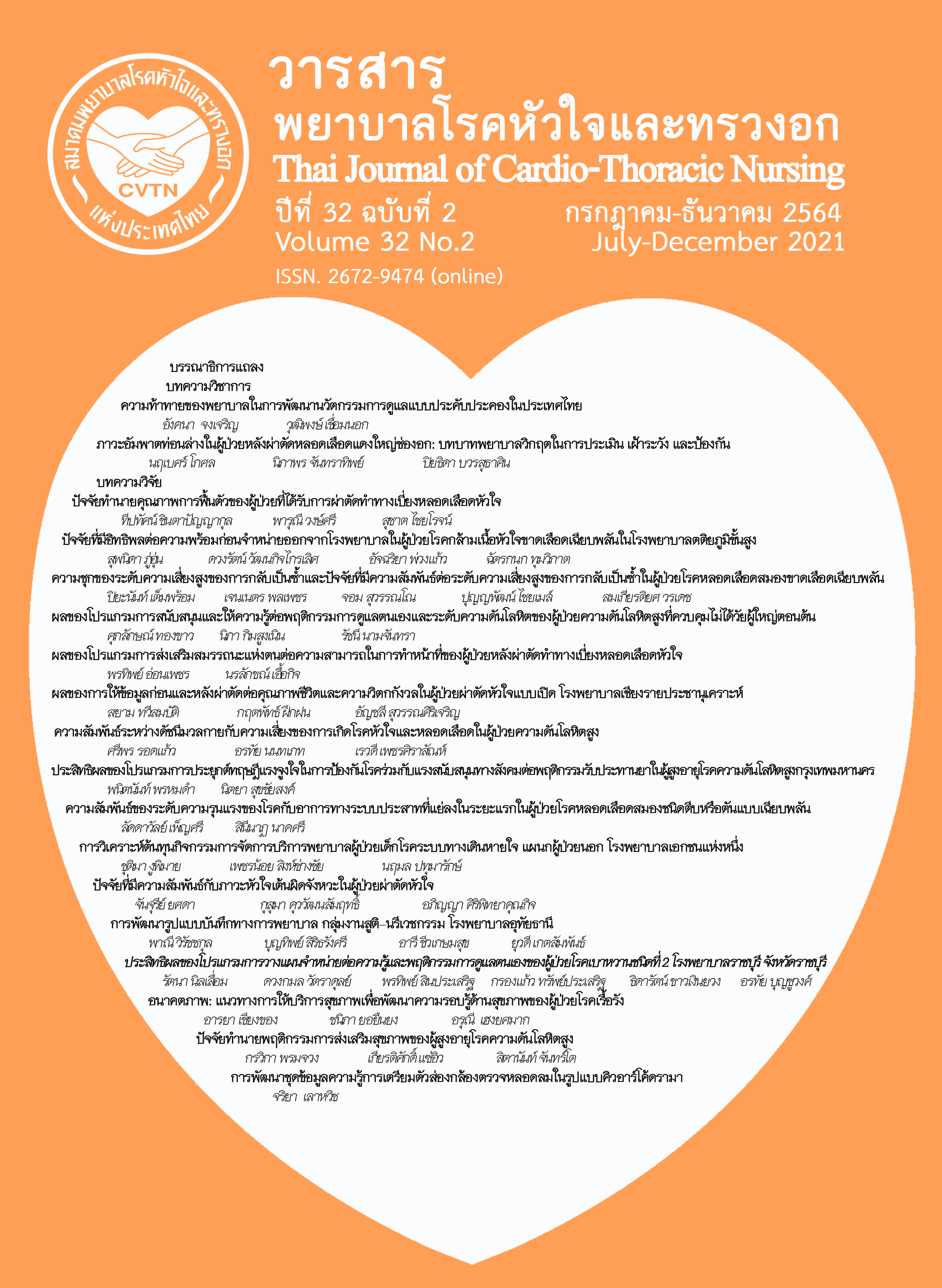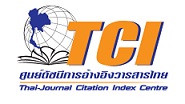ความสัมพันธ์ของระดับความรุนแรงของโรคกับอาการทางระบบประสาทที่แย่ลงในระยะแรกในผู้ป่วยโรคหลอดเลือดสมองชนิดตีบหรือตันแบบเฉียบพลัน
คำสำคัญ:
อาการทางระบบประสาทที่รุนแรงขึ้นในระยะแรก, โรคหลอดเลือดสมองชนิดตีบตันแบบเฉียบพลัน, ระดับความรุนแรงของโรคหลอดเลือดสมองบทคัดย่อ
การศึกษาวิจัยนี้เป็นการวิจัยเชิงบรรยายเพื่อศึกษาความสัมพันธ์เชิงการทำนายของระดับความรุนแรงของโรคหลอดเลือดสมองกับอาการทางระบบประสาทที่แย่ลงในระยะแรก (Early neurologic deterioration: END) ในผู้ป่วยโรคหลอดเลือดสมองชนิดตีบตันแบบเฉียบพลันตามกรอบแนวคิดการจัดการอาการ กลุ่มตัวอย่างคือข้อมูลทุติยภูมิในระบบบันทึกข้อมูลผู้ป่วยโรคหลอดเลือดสมอง โรงพยาบาลหาดใหญ่ จังหวัดสงขลา ตั้งแต่เดือนตุลาคม 2554 จนถึง กุมภาพันธ์ 2559 คัดเลือกตามเกณฑ์การคัดเข้าได้จำนวน 3,110 ราย โรงพยาบาลหาดใหญ่ จังหวัดสงขลา เก็บข้อมูลโดยใช้แบบประเมินความรุนแรงของการเจ็บป่วยด้วย National Institute of Health Stroke Scale (NIHSS), Glasgow Coma Scale (GCS), modified Rankin Scale (mRS), Barthel index (BI) วิเคราะห์ข้อมูลโดยใช้สถิติ Chi-Square และ Logistic regression statistic ค่าความเชื่อมั่นที่ร้อยละ 95
ผลการศึกษาพบว่า กลุ่มตัวอย่างมีภาวะ END ร้อยละ 7.96 ซึ่งพบว่า NIHSS, GCS, mRS, BI, อายุ, การสูบบุหรี่และการดื่มแอลกอฮอล์สามารถทำนายการเกิด END ได้ โดยเมื่อปรับอิทธิพลร่วมของทุกปัจจัยพบว่า กลุ่มตัวอย่างที่มีค่า NIHSS ระดับเล็กน้อย-ปานกลาง มีโอกาสเกิด END เป็น 1.69 เท่า (OR 1.69; 95% CI 1.09-2.62) ของกลุ่มที่มีค่า NIHSS ระดับรุนแรงมาก GCS ระดับเล็กน้อย-ปานกลาง มีโอกาสเกิด END เป็น 14.52 เท่า (OR 14.52; 95% CI 9.24-22.83) ของกลุ่มที่มีค่า GCS ระดับรุนแรงมาก ค่า mRS ระดับเล็กน้อย-ปานกลาง มีโอกาสเกิด END เป็น 2.41 เท่า (OR 2.41; 95% CI 1.65-3.52) ของกลุ่มที่มีค่า mRS ระดับรุนแรงมาก และค่า BI ไม่แตกต่างกันระหว่างผู้ป่วยกลุ่มที่เกิดและไม่เกิด END
ผลการวิจัยที่ได้สามารถนำไปใช้เป็นแนวทางในการดูแลผู้ป่วยโรคหลอดเลือดสมอง โดยใช้เครื่องมือประเมินความรุนแรงของโรคเพื่อเฝ้าระวังการเกิดอาการทางระบบประสาทที่แย่ลงในระยะแรก END และให้การดูแลได้อย่างรวดเร็ว ซึ่งส่งผลให้ลดอัตราการเกิดภาวะแทรกซ้อนที่รุนแรงได้
References
Cuadrado-Godia E. Early neurological deterioration, easy methods to detect it. Indian J. Med. Res. 2015; 141(3):266-68.
Martin AJ, Price CI. A systematic review and meta-analysis of molecular biomarkers associated with early neurological deterioration following acute stroke. Cerebrovasc. Dis. 2018; 46(5-6): 230-41.
Siegler JE, Samai A, Semmes E, Martin-Schild S. Early neurologic deterioration after stroke depends on vascular territory and stroke etiology. J Stroke. 2016 May;18(2):203-10. doi: 10.5853/jos.2016.00073. Epub 2016 May 31. PMID: 27283280; PMCID: PMC4901951.
Hou X, Chen W, Xu H, Zhu Z, Xu Y, Chen H. The rate of early neurological deterioration occurring after thrombolytic therapy: a meta‐analysis. Brain Behav. 2019; 9(2): e01210. doi:10.1002/brb3.121
Hartmann A, Kuschinsky W, editors. Cerebral ischemia and hemorheology. Berlin-Heidelberg- New York-Tokyo: Springer-Verlag; 1987.
Hinkle LA, Cheever KH, editors. Brunner & Suddarth's Textbook of Medical-Surgical Nursing. Philadelphia: Wolters Kluwer Lippincott Williams & Wilkins; 2014.
Geng HH, Wang Q, Li B, Cui BB, Jin YP, Fu RL, et al. Early neurological deterioration during the acute phase as a predictor of long-term outcome after first-ever ischemic stroke. Medicine (Baltimore). 2017 Dec; 96(51):e9068. doi: 10.1097/MD.0000000000009068. PMID: 2939 0435; PMCID: PMC5758137.
Kim YD, Song D, Kim EH, Lee KJ, Lee HS, Nam CM, Nam HS, Heo JH. Long-term mortality according to the characteristics of early neurological deterioration in ischemic stroke patients. Yonsei Med J. 2014 May;55(3):669-75. doi: 10.3349/ymj.2014.55.3.669. Epub 2014 Apr 1. PMID: 24719133; PMCID: PMC3990074.
Dodd M, Janson S, Facione N, Faucett J, Froelicher ES, Humphreys J, Lee K, Miaskowski C, Puntillo K, Rankin S, Taylor D. Advancing the science of symptom management. J Adv Nurs. 2001 Mar; 33(5):668-76. doi: 10.1046/j.1365-2648.2001.01697.x. PMID: 11298204.
Harrison JK, McArthur KS, Quinn TJ. Assessment scales in stroke: clinimetric and clinical considerations. Clin Interv Aging. 2013;8:201-11. doi: 10.2147/CIA.S32405. Epub 2013 Feb 18. PMID: 23440256; PMCID: PMC3578502.
Shahsavarinia, K., Ghavam Laleh, Y., Moharramzadeh, Pouraghaei M, Sadeghi Hokmabadi, E, Seifar F, Hajibonabi F, et al. The predictive value of red cell distribution width for stroke severity and outcome. BMC Res Notes 2020; 13, 288. https://doi.org/10.1186/s 13104- 020-05125-y
Jain S, Iverson LM. Glasgow Coma Scale. [document on the internet]. 2020 [cited 2020 June 28]. Available from: https://www ncbi .nlm.nih.gov/books/NBK513298.
Lee SY, Kim DY, Sohn MK, Lee J, Lee S-G, Shin Y-I, et al. Determining the cut-off score for the Modified Barthel Index and the Modified Rankin Scale for assessment of functional independence and residual disability after stroke. PLos One. 2020; 15(1): e0226324-e.
Tseng MC, Chang KC. Stroke severity and early recovery after first-ever ischemic stroke: results of a hospital-based study in Taiwan. Health Policy (Amsterdam, Netherlands). 2006 Nov;79(1):73-78. DOI: 10.1016/j.healthpol.2005. 12.003. PMID: 16406133.
Bhatia K, Mohanty S, Tripathi BK, Gupta B, Mittal MK. Predictors of early neurological deterioration in patients with acute ischaemic stroke with special reference to blood urea nitrogen (BUN)/creatinine ratio & urine specific gravity. Indian J Med Res. 2015Mar;141(3):299-307. doi: 10.4103/0971-5916. 156564. PMID: 25963490; PMCID: PMC4442327
Zhang X, Sun Z, Ding C, Tang Y, Jiang X, Xie Y, et al. Metabolic syndrome augments the risk of early neurological deterioration in acute ischemic stroke patients independent of inflammatory mediators: a hospital-based prospective study. Oxid Med Cell Longev. 2016;2016:8346301. doi: 10.1155/2016/834 6301. Epub 2016 Mar 29. PMID: 27119010; PMCID: PMC4828543.
Irvine HJ, Battey TW, Ostwaldt A-C, Campbell BC, Davis SM, Donnan GA, et al. Early neurological stability predicts adverse outcome after acute ischemic stroke. Int J Stroke. 2016; 11(8): 882-9.
Lord AS, Gilmore E, Choi HA, Mayer SA. Time course and predictors of neurological deterioration after intracerebral hemorrhage. Stroke. 2015; 46(3): 647-52.
Siegler JE, Boehme AK, Kumar AD, Gillette MA, Albright KC, Beasley TM, et al. Identification of modifiable and nonmodifiable risk factors for neurologic deterioration after acute ischemic stroke. J Stroke Cerebrovasc Dis. 2013 Oct; 22(7):e207-13.doi:10.1016/j.jstrokecerebrovas dis. 2012.11.006. Epub 2012 Dec 16. PMID: 23246190; PMCID: PMC3690312.
Downloads
เผยแพร่แล้ว
How to Cite
ฉบับ
บท
License
Copyright (c) 2022 วารสารพยาบาลโรคหัวใจและทรวงอก

This work is licensed under a Creative Commons Attribution-NonCommercial-NoDerivatives 4.0 International License.
บทความนี้ยังไม่เคยตีพิมพ์หรืออยู่ในระหว่างส่งไปตีพิมพ์ในวารสารอื่น ๆ มาก่อน และกองบรรณาธิการขอสงวนสิทธิ์ในการตรวจทาน และแก้ไขต้นฉบับตามเกณฑ์ของวารสาร ในกรณีที่เรื่องของท่านได้ได้รับการตีพิมพ์ในวารสารฉบับนี้ถือว่าเป็น ลิขสิทธิ์ของวารสารพยาบาลโรคหัวใจและทรวงอก





